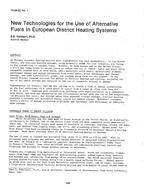Description
In Europe, district heating systems with cogeneration are used extensively. States, In the United old district heating systems, using primarily steam for heat transfer, are losing in the competition to cheaper fuels. However, in both Europe and in the United States, a shift has taken place in recent years to reduce the use of fossil fuels and start using renewable sources such as wood waste, peat, municipal solid waste, agricultural biomass, geothermal energy and energy extraction from waste water, solar assistance and thermal storage, low peak hydroelectric power, and cooling water from nuclear plants. In the United States, renewed interest has arisen in district heating and cooling, including the use of hot water systems and research in the use of renewable sources of energy.
Cogeneration for district heating and cooling is by itself a form of energy conservation as the fuel efficiency of a power plant is raised from a level of often less than 30% to 80% or more. Combined with retrofitting buildings with superinsulation on a community-wide basis, and with new technologies and efficiencies gained with the use of low temperature, low pressure hot water, and chilled water from seasonal storage systems, district heating provides a reliable and economical energy source for modern cities. Multifuel equipment offers a choice of energy production strategies and increases fuel efficiency in community-wide systems.
Units: Dual
Citation: Symposium, ASHRAE Transactions, 1985, vol. 91, pt. 2B, Honolulu, HI
Product Details
- Published:
- 1985
- Number of Pages:
- 14
- File Size:
- 1 file , 2.5 MB
- Product Code(s):
- D-HI-85-32-1




